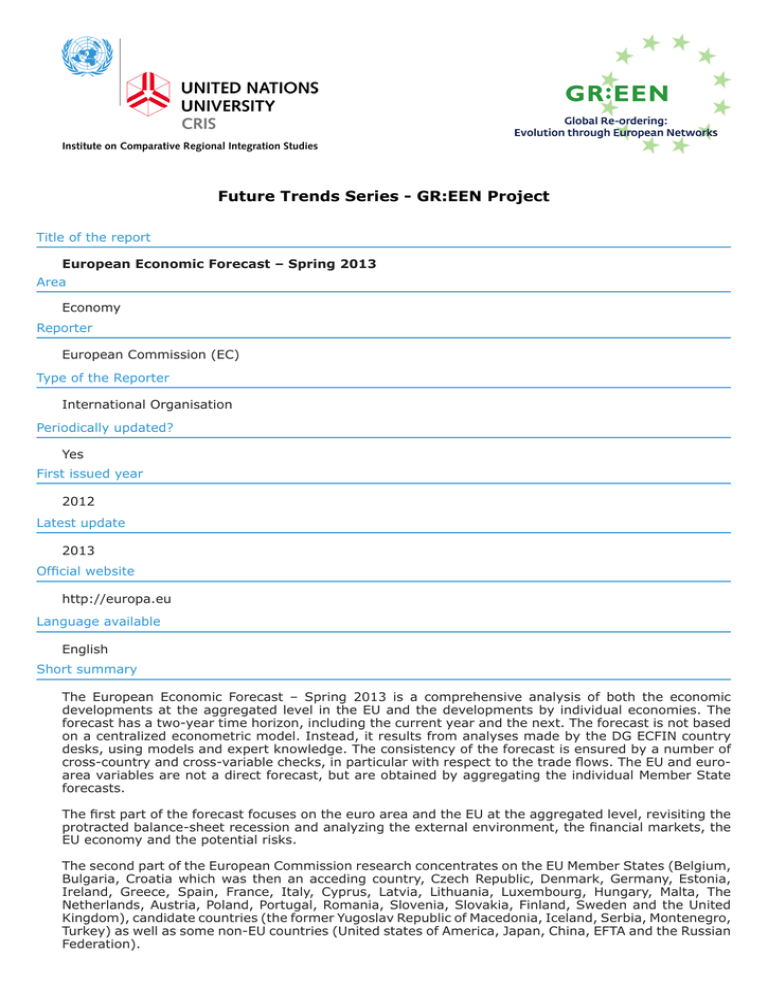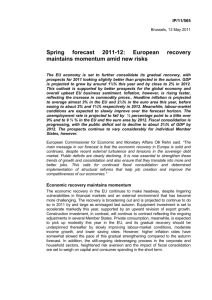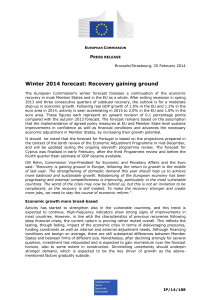Future Trends Series - GR:EEN Project
advertisement

Future Trends Series - GR:EEN Project Title of the report European Economic Forecast – Spring 2013 Area Economy Reporter European Commission (EC) Type of the Reporter International Organisation Periodically updated? Yes First issued year 2012 Latest update 2013 Official website http://europa.eu Language available English Short summary The European Economic Forecast – Spring 2013 is a comprehensive analysis of both the economic developments at the aggregated level in the EU and the developments by individual economies. The forecast has a two-year time horizon, including the current year and the next. The forecast is not based on a centralized econometric model. Instead, it results from analyses made by the DG ECFIN country desks, using models and expert knowledge. The consistency of the forecast is ensured by a number of cross-country and cross-variable checks, in particular with respect to the trade flows. The EU and euroarea variables are not a direct forecast, but are obtained by aggregating the individual Member State forecasts. The first part of the forecast focuses on the euro area and the EU at the aggregated level, revisiting the protracted balance-sheet recession and analyzing the external environment, the financial markets, the EU economy and the potential risks. The second part of the European Commission research concentrates on the EU Member States (Belgium, Bulgaria, Croatia which was then an acceding country, Czech Republic, Denmark, Germany, Estonia, Ireland, Greece, Spain, France, Italy, Cyprus, Latvia, Lithuania, Luxembourg, Hungary, Malta, The Netherlands, Austria, Poland, Portugal, Romania, Slovenia, Slovakia, Finland, Sweden and the United Kingdom), candidate countries (the former Yugoslav Republic of Macedonia, Iceland, Serbia, Montenegro, Turkey) as well as some non-EU countries (United states of America, Japan, China, EFTA and the Russian Federation). Key trends • From stabilization to modest expansion. After the recession that marked the year 2012, the EU economy is forecast to stabilize slowly in the course of the first half of 2013. A noticeable expansion of GDP is expected to set in only in the second half of the year, but growth should pick up at a moderate speed in 2014. For 2014, GDP growth is forecast at 1½% in the EU and 1¼% in the euro area, which is expected to be just strong enough to exceed the employment threshold and start reducing output gaps. • More support from the external environment. Outside the EU, economic activity, which had weakened in the course of 2012, appears to have bottomed out. For 2013, global GDP growth is projected at 3%. World imports are expected to grow by 3¼% this year, visibly faster than the EU Member States’ export markets. Also dampened by the past appreciation of the euro, EU exports are therefore forecast to increase by only 2%. • Little financial market developments. Financial market conditions have remained overall favorable in the EU following the very significant improvements in the second half of 2012. However, market sentiment has become less upbeat in recent months as incoming macroeconomic indicators were weaker than expected and the improvement of confidence was interrupted. The easing in financial market conditions has not reached all countries, and it has not yet led to an improvement in the real economy. • Domestic demand returns only very slowly. A gradual increase in domestic demand is expected in the second half of this year. The annual growth rates for private consumption and investment in the EU are however projected to remain negative, at -½% and -1¾% respectively, in view of the negative carry-over effect from 2012. The recovery of private consumption is predicted to be very slow. While net exports are projected to remain the main driver of GDP growth in the EU this year, firming domestic demand is expected to take over this role in 2014. On a more positive note, potential growth, estimated at only ½% in the EU in 2013, is expected to recover gradually over time as structural unemployment is reduced and investment activity normalizes. In other words, despite the level shift in EU GDP, its growth dynamics should not be affected in the long term. • Growth differentials expected to moderate. While no Member State has been immune to the impact of the economic and financial crisis, differentials in GDP growth and labor market situation across countries remain large. Yet, by the end of this year, most of the Member States that are currently in recession are expected to register positive quarterly GDP growth again, and the upswing is set to strengthen in 2014 across the EU. However, the large differences in unemployment that have built up will take a long time to be absorbed. • Adjustment is making progress. External and internal adjustment is making further progress. In 2013, the current account of several vulnerable Member States is expected to turn positive, helped by lower domestic absorption as well as competitiveness gains on the back of wage moderation and increased productivity. • Unemployment is set to worsen in the near future. Joblessness has increased steadily over the past two years, reaching 12% in the euro area and 11% in the EU with a very large degree of divergence across Member States. Survey data suggest a further deterioration of the labor-market situation in the near term, given the usually lagged response of employment to GDP. In 2013, employment is expected to decrease further by ½% in the EU and ¾% in the euro area. For 2014, modest employment gains around ½% in the EU and ¼% in the euro area are forecast. • Well-anchored inflation. The gradual decrease in consumer-price inflation has accelerated in recent months. Core inflation (headline HICP excluding unprocessed food and energy) is projected to remain stable at around 1¾% in the EU and 1½% in the euro area over the forecast horizon, despite the fading impact of past increases in indirect taxes and administered prices as well as the waning pass-through of energy price hikes. Headline inflation is expected to average 1.8% in the EU and 1.6% in the euro area this year and to decline further to 1.7% and 1.5% respectively in 2014. • Slower speed of structural fiscal consolidation. Fiscal consolidation is set to continue over the forecast horizon. As many Member States are implementing sizeable fiscal measures, headline fiscal deficits are projected to fall to 3.4% in the EU and 2.9% in the euro area in 2013. The pace of consolidation in structural terms is expected to slow down compared to 2012. The structural deficit is expected to decrease from 2.8% in 2012 to 2.0% in 2013 in the EU, and from 2.1% to 1.4% in the euro area. Under the customary no-policy-change assumption, the pace of consolidation would slow down further in 2014. • Outlook still clouded by high uncertainty. On the back of important policy decisions since last summer, perceived redenomination risks have largely been dispelled. Yet, with uncertainty about economic perspectives remaining high and a fragile macro-financial situation, downside risks continue to largely prevail. Suggestions • It is of the outmost importance to press ahead with the implementation of the Banking Union in order to overcome financial fragmentation as part of completing the architecture of EMU, facilitate structural adjustment and unlock domestic demand. By moving forward with the necessary reforms, the EU and the Member States can create the conditions for the improved financial market situation to feed through to growth in the real economy and set in motion virtuous circles between growth, declining debt levels and more stable financial conditions. Methodology Modelling Reference to other trends reports? If yes, which reports? /





